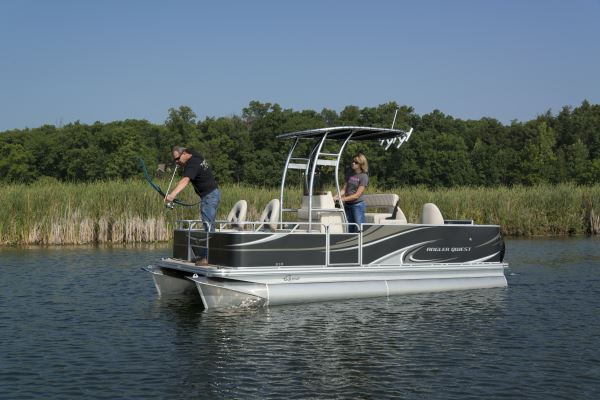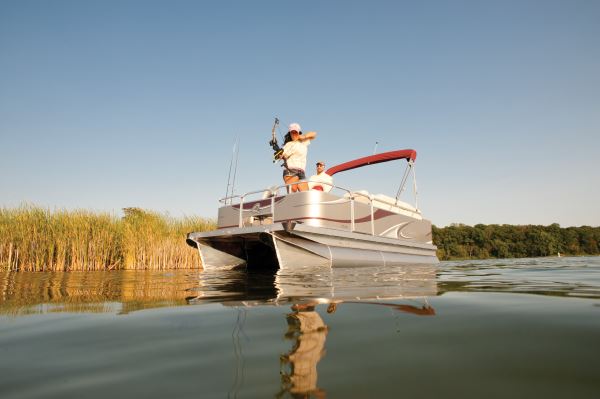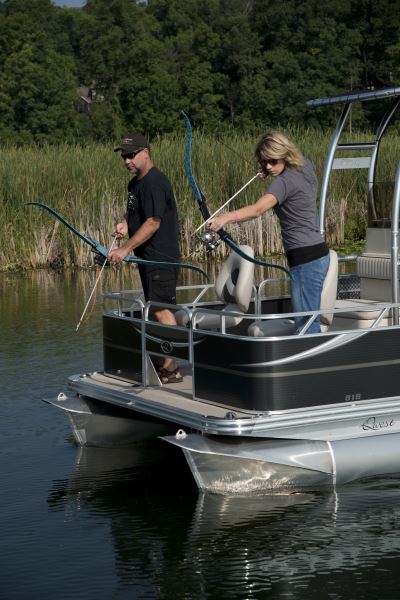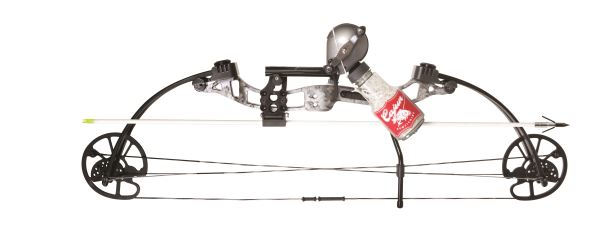
This article originally appeared in the June 2015 issue
Broad, high and open at the bow and stable as can be, it’s no wonder pontoon boats are among the most popular platforms found underfoot of folks engaged in bowfishing. We plan to give the sport a try this season, making lemonade out of lemons with the countless carp that invade and dominate the shallow, mud-bottom bays of the lake where we keep our family FloteBote.
In preparation for doing so, we’ve fitted used recurve bows we stumbled across at a rural Salvation Army resale store with aftermarket bowfishing kits offered by Cajun Archery. By the time you read this, we hope to have arrowed our first carp and maybe bagged a gar or two from the bow of our pontoon boat.

I actually got the idea for giving bowfishing a try from a photo I ran across while seeking art for a PDB fishing column last autumn, and ran across the image of a female bowfisher at full draw on a fish while standing on the bow of a Qwest pontoon. It got me to thinking about all those carp in our local lake and the fact that both my son and I are getting into bow hunting for deer. I figured that angling with archery gear might be an enjoyable way to keep us in bow-shooting form for the fall whitetail season – and be a fun new way to use our pontoon boat to boot.
Why Pontoons?
To learn more about bowfishing from pontoons, I got in touch with Brad Dupuie at Apex Marine, which manufactures the Qwest line of boats featured in the inspirational photo. The product and engineering manager for the Michigan-based boat manufacturer explained that pontoon boats are a popular boat-of-choice by bowfishers for a variety of reasons.

“Stability is probably the main reason pontoons are so popular,” Dupuie explained. “Instead of one keel underfoot, as with a mono-hull boat, you’ve got two keels spread 6 feet apart supporting an 8-foot-wide deck. When you’re standing up and attempting to take a carefully-aimed shot, that stability is paramount.
“You are also up high above the water’s surface aboard a pontoon,” he added. “That height gives you a better view of the surrounding water and any fish in the vicinity and a better angle at which to shoot at the fish.”
As does the ability to stand at the extreme far forward edge of the bow of the boat, which can be deftly moved into position using a bow-mounted electric trolling motor and a foot control, leaving both hands free to hold, draw and shoot the bow and arrow combo. Pontoons also offer the shallow draft often required to access and prowl the shallows searching for carp and other non-gamefish species that are the popular targets of bow-fishers.
Centered On Success
While most pontoon boat models and layouts should work well for bowfishing, Dupuie mentioned that the Qwest Fish and the Qwest Troll fishing model pontoons from Apex come with center console steering, allowing for 360 degrees of deck access when drawing a bead on a finned target—or fighting a fish to the boat—arrowed or otherwise. Those specialized fishing models are overkill for most bow fishing situations, but a review of the Apex offering reveals several more affordable pontoon boat models with wide open decks, especially in the Outfitter line.
Although avid bow anglers may use modern compound bows and accessories equivalent to the cutting edge archery equipment used by deer hunters, the basic equipment needed for shooting fish with a bow and arrow is simple. You can use a recurve bow or a compound designed for deer hunting or even target shooting, and lighter draw weights of 25 to 50 pounds are adequate for shooting most freshwater fishing for carp and smaller gar. Many bowhunters have an old recurve or compound lying around that would be fine for bowfishing, or you can do what we did and shop the resale stores or go online to find used bows. Companies such as Cajun Archery (www.cajunbowfishing.com) and Bohning Archery (www.bohning.com) offer basic bowfishing kits that include everything you need to convert a traditional bow into a bowfishing rig starting at under $50. Both companies offer fully-rigged kits as well, including bow, reel, arrows and line.
 We have learned that after getting within shooting range of a fish, the biggest hurdle facing beginning bow anglers is compensating for refraction, or the bending of the light’s rays in the water, which makes fish appear to be above where they actually are in the water. Until it becomes instinctual with experience, we’ve been advised to aim 6 inches to a foot below the image of the fish we see in order for our arrow to connect. That or practice on submerged milk jugs, which we are collecting as we speak. We’ll let you know how that goes. Meanwhile: bring on the carp!
We have learned that after getting within shooting range of a fish, the biggest hurdle facing beginning bow anglers is compensating for refraction, or the bending of the light’s rays in the water, which makes fish appear to be above where they actually are in the water. Until it becomes instinctual with experience, we’ve been advised to aim 6 inches to a foot below the image of the fish we see in order for our arrow to connect. That or practice on submerged milk jugs, which we are collecting as we speak. We’ll let you know how that goes. Meanwhile: bring on the carp!
Most states allow bowfishing for all types of rough fish year-round with a standard fishing license. However, be sure to check your local spearing, netting and licensing regulations before you head out, to ensure that you are fishing within the law. Cajun Bowfishing offers a link to each state’s fishing regulations agency at www.cajunbowfishing.com.

